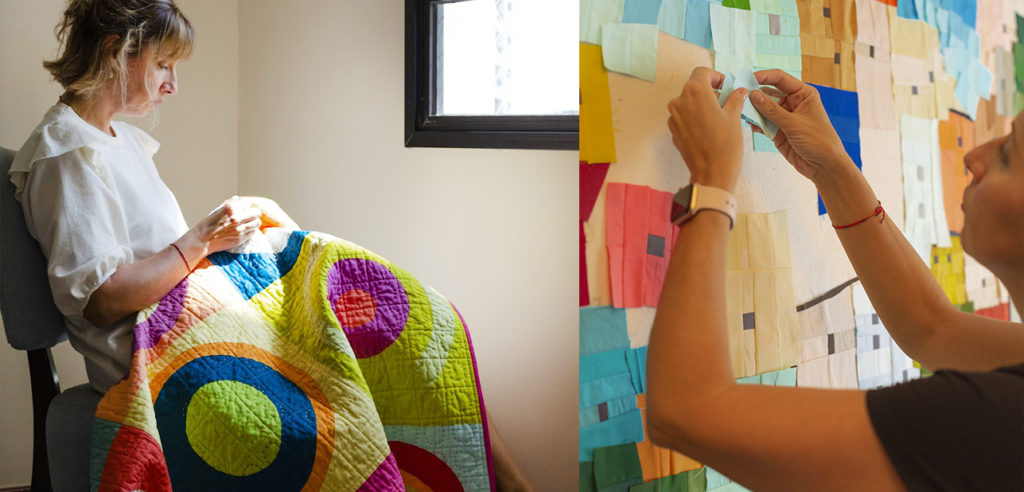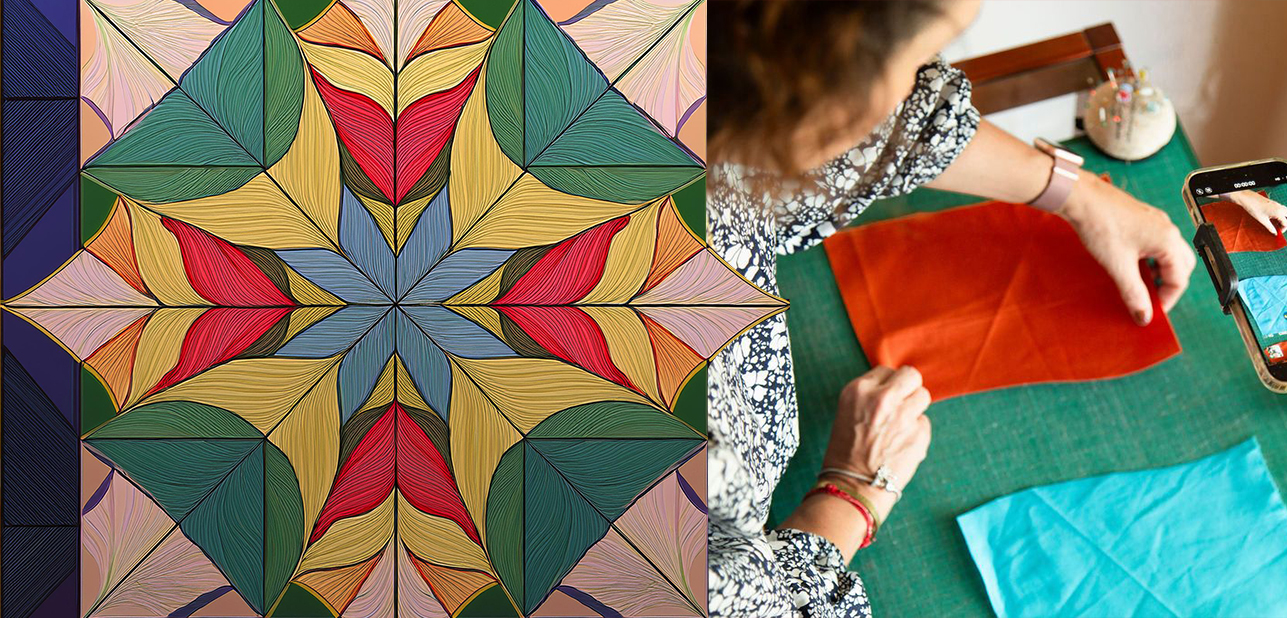Quilts can have a balance of order and disorder that makes them stand out. When you think about quilt design, do you prefer structured patterns or something a bit more unexpected? The use of symmetry and asymmetry in quilt design is what makes that choice so impactful.
In this blog, we’ll dive into the differences between the two, why balancing them creates unique quilts, and how you can apply these ideas in your own projects. We’ll also include some practical tips for blending these techniques effectively. Carolina Oneto, a seasoned quilt instructor, will guide you through the basics. Expect to learn valuable insights to refine your quilting skills.

The Role of Symmetry in Quilts
Symmetry in quilt design refers to the even arrangement of visual elements across a central axis. This creates a mirrored, balanced appearance. Whether it’s geometric patterns or repetitive shapes, symmetry gives a sense of order. Quilters often use symmetrical designs when they want a clean, formal look. The overall impact is a feeling of calm and stability, making it a popular choice for traditional quilts.



Visual Appeal of Symmetry
Symmetrical designs create a predictable rhythm. This rhythm can guide the viewer’s eye smoothly across the quilt. Stars, pinwheels, and other repeated shapes are common in these designs. By relying on this structure, quilters can make visually harmonious pieces. This type of design often has a timeless appeal. It looks orderly and elegant, which can be soothing for many people.
Practical Use of Symmetry in Quilts
Symmetry is used in many quilt blocks like log cabins, nine-patches, and flying geese. These blocks are easy to assemble in a repetitive, structured way. Quilters love this approach when they want consistent results. Even small changes in fabric color or texture won’t disrupt the overall flow. Because of its balance, symmetry offers simplicity in execution and predictability in design.

Considerations in Symmetry and Quilt Design
While symmetry is effective, it can sometimes feel too predictable. Overly symmetrical quilts may lack movement or excitement. Half the design simply mirrors the other, which may limit creativity. Symmetrical quilts, when not thoughtfully balanced, can feel static. That’s where the mix of symmetry and asymmetry in quilt design becomes important.
The Power of Asymmetry in Quilts
Asymmetry in quilt design involves distributing visual elements unevenly across the quilt. Unlike symmetrical designs, this approach creates a more dynamic and unpredictable look. Quilters often use asymmetry when they want their quilts to feel modern or energetic. This design choice allows for freedom in layout and structure, often leading to a more creative and unique result.
Visual Appeal of Asymmetry
Asymmetry introduces movement and energy into quilts. Irregular shapes, different block sizes, and varied orientations draw attention. Viewers’ eyes are naturally guided across the quilt, creating a sense of flow. Unlike symmetrical designs, asymmetry tends to surprise, adding complexity to the overall look. It gives quilts a modern and fresh feel, making them stand out in contemporary designs.
Practical Advantages of Asymmetry
One of the benefits of asymmetry is its ability to camouflage imperfections. Since the design doesn’t rely on perfect repetition, piecing inaccuracies may go unnoticed. By shifting the viewer’s focus to specific areas, asymmetry helps draw attention away from flaws. This makes it ideal for quilters who want flexibility in their work while still achieving a visually striking result.
Achieving Balance in Asymmetry
Creating balance with asymmetry requires careful thought. Even though the design is intentionally uneven, it still needs visual harmony. Quilters need to consider the relationship between shapes, colors, and placement to avoid a chaotic look. This can be more challenging than working with symmetry, but it opens up new possibilities. Combining symmetry and asymmetry in quilt design allows for balance and creativity, making each quilt truly one of a kind.


Finding Balance in Quilt Design
Balancing symmetry and asymmetry in quilt design creates a striking visual composition. It blends the order of symmetry with the dynamic energy of asymmetry. Quilters often use this approach to keep their designs from feeling too predictable or chaotic. By combining both techniques, you can craft quilts that are engaging and visually balanced.
Using Symmetry for Structure
Symmetry provides a foundation for quilt design. It offers a sense of order and consistency. When quilters use symmetrical blocks or patterns, they create a stable layout. This structure helps to define clear visual boundaries. The repetition of shapes, sizes, and colors provides an anchor for the entire quilt. By starting with symmetrical elements, quilters can establish a balanced framework to build upon.
Adding Energy with Asymmetry
Asymmetry brings movement and excitement to quilt designs. Irregular shapes, varying block sizes, and unexpected layouts add interest to the overall composition. By introducing asymmetrical elements, quilters can break up the predictability of symmetrical patterns. This creates a sense of flow, drawing the viewer’s eye across the quilt. Asymmetry keeps the design fresh and prevents it from feeling static.
Creating Visual Focal Points
Combining symmetry and asymmetry in quilt design allows for the creation of focal points. Symmetry naturally draws attention, acting as a central point of focus. Asymmetry can then guide the eye away from these focal points, adding rhythm and movement. By alternating between symmetrical and asymmetrical elements, quilters can create depth and visual variety in their designs.



Achieving Harmony
The key to balancing symmetry and asymmetry lies in careful placement. A quilt needs both structure and freedom. Symmetry provides the foundation, while asymmetry adds complexity. When done thoughtfully, the combination prevents quilts from feeling too uniform or chaotic. This harmony results in quilts that are interesting without overwhelming the viewer, making the best use of both design techniques.
Simple Tips for Quilters
When working with symmetry and asymmetry in quilt design, quilters have plenty of room for creativity. Finding the right balance between these two approaches can help create visually engaging quilts. Here are some practical tips to help you use symmetry and asymmetry effectively.

Mixing Block Orientation
Experimenting with block orientation can add variety to your quilts. Symmetrical blocks like stars or pinwheels provide structure, but placing them in an asymmetrical layout creates visual tension. This balance between symmetry and asymmetry in quilt design keeps the quilt dynamic without losing cohesion. Try different orientations to see how the blocks interact with one another.
Creating Movement with Asymmetry
If your goal is to create movement, asymmetry is an effective tool. Asymmetrical quilting designs can guide the viewer’s eye in specific directions, adding flow. You can achieve this by adjusting the size, shape, or arrangement of blocks. This method works well for quilters looking to make their quilts feel more alive and engaging.
Hiding Imperfections
Sometimes piecing imperfections happen. Asymmetry can help disguise them. By drawing attention to certain areas of the quilt, asymmetrical elements divert focus from flaws. For example, use asymmetrical patterns in quilting or piecing to create interest and take attention away from problem areas. This makes the design more forgiving.
Balancing Negative Space
Incorporating negative space is a great way to balance symmetry and asymmetry in quilt design. Large, open areas can make an asymmetrical layout feel less chaotic. Use these spaces strategically to create contrast and add depth. Negative space can highlight bold design choices while making the overall composition feel more balanced.
Combining Symmetry and Asymmetry
Layering symmetrical and asymmetrical elements can lead to unique quilt designs. For example, symmetrical piecing can anchor the quilt, while asymmetrical patterns bring creativity. This approach allows quilters to explore both techniques in harmony, making the design more versatile. It’s a way to blend tradition with modern touches.
Learn Quilting with Carolina Oneto
Meet Carolina Oneto
Carolina Oneto is a passionate and experienced quilting instructor with a global reputation. She has a deep understanding of color theory and improvisation, developed from her studies and practice over many years. Quilters from around the world admire her innovative techniques and commitment to modern quilting. Carolina’s approach blends creativity with precision, making her an excellent mentor for anyone looking to master both symmetry and asymmetry in quilt design.

Master Symmetry and Asymmetry with Carolina
Carolina’s teaching emphasizes how to balance symmetry and asymmetry in quilt design. She explains how to achieve this through structured lessons that focus on using both elements effectively. Carolina’s workshops guide students through creating balanced quilts that feel dynamic yet cohesive. Quilters learn how to make symmetrical blocks while incorporating asymmetrical details for added movement and interest. She breaks down complex techniques into easy-to-understand steps.
Why Learn From Carolina Oneto?
Carolina’s dedication to teaching shines through in her detailed, interactive workshops. She offers live virtual classes where students can follow along in real time, ask questions, and receive feedback. Her teaching style is clear and supportive, encouraging creativity while guiding students toward improvement.
Connect and Learn
Carolina’s workshops are accessible worldwide, allowing quilters from different countries to join and learn. Whether you’re just beginning or refining your skills, she can help you improve your mastery of symmetry and asymmetry in quilt design. Carolina offers individual meetings for those who need personalized guidance. Reach out to explore her workshops and connect with us today!


